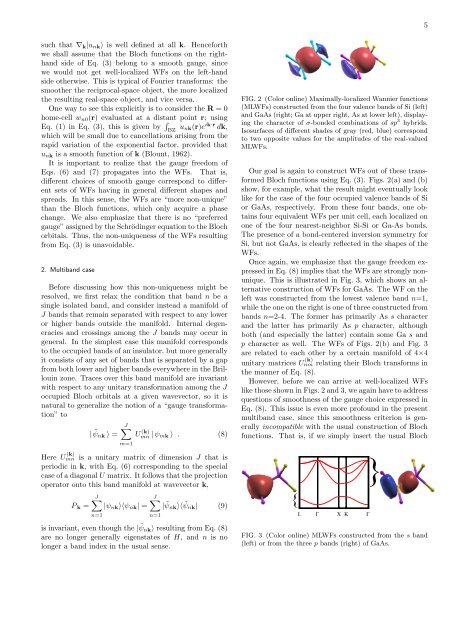Maximally localized Wannier functions: Theory and applications
Maximally localized Wannier functions: Theory and applications
Maximally localized Wannier functions: Theory and applications
You also want an ePaper? Increase the reach of your titles
YUMPU automatically turns print PDFs into web optimized ePapers that Google loves.
5<br />
such that ∇ k |u nk ⟩ is well defined at all k. Henceforth<br />
we shall assume that the Bloch <strong>functions</strong> on the righth<strong>and</strong><br />
side of Eq. (3) belong to a smooth gauge, since<br />
we would not get well-<strong>localized</strong> WFs on the left-h<strong>and</strong><br />
side otherwise. This is typical of Fourier transforms: the<br />
smoother the reciprocal-space object, the more <strong>localized</strong><br />
the resulting real-space object, <strong>and</strong> vice versa.<br />
One way to see this explicitly is to consider the R = 0<br />
home-cell w n0 (r) evaluated at a distant point r; using<br />
Eq. (1) in Eq. (3), this is given by ∫ BZ<br />
u nk(r)e ik·r dk,<br />
which will be small due to cancellations arising from the<br />
rapid variation of the exponential factor, provided that<br />
u nk is a smooth function of k (Blount, 1962).<br />
It is important to realize that the gauge freedom of<br />
Eqs. (6) <strong>and</strong> (7) propagates into the WFs. That is,<br />
different choices of smooth gauge correspond to different<br />
sets of WFs having in general different shapes <strong>and</strong><br />
spreads. In this sense, the WFs are “more non-unique”<br />
than the Bloch <strong>functions</strong>, which only acquire a phase<br />
change. We also emphasize that there is no “preferred<br />
gauge” assigned by the Schrödinger equation to the Bloch<br />
orbitals. Thus, the non-uniqueness of the WFs resulting<br />
from Eq. (3) is unavoidable.<br />
2. Multib<strong>and</strong> case<br />
Before discussing how this non-uniqueness might be<br />
resolved, we first relax the condition that b<strong>and</strong> n be a<br />
single isolated b<strong>and</strong>, <strong>and</strong> consider instead a manifold of<br />
J b<strong>and</strong>s that remain separated with respect to any lower<br />
or higher b<strong>and</strong>s outside the manifold. Internal degeneracies<br />
<strong>and</strong> crossings among the J b<strong>and</strong>s may occur in<br />
general. In the simplest case this manifold corresponds<br />
to the occupied b<strong>and</strong>s of an insulator, but more generally<br />
it consists of any set of b<strong>and</strong>s that is separated by a gap<br />
from both lower <strong>and</strong> higher b<strong>and</strong>s everywhere in the Brillouin<br />
zone. Traces over this b<strong>and</strong> manifold are invariant<br />
with respect to any unitary transformation among the J<br />
occupied Bloch orbitals at a given wavevector, so it is<br />
natural to generalize the notion of a “gauge transformation”<br />
to<br />
| ˜ψ nk ⟩ =<br />
J∑<br />
m=1<br />
U (k)<br />
mn | ψ mk ⟩ . (8)<br />
Here U mn<br />
(k) is a unitary matrix of dimension J that is<br />
periodic in k, with Eq. (6) corresponding to the special<br />
case of a diagonal U matrix. It follows that the projection<br />
operator onto this b<strong>and</strong> manifold at wavevector k,<br />
P k =<br />
J∑<br />
|ψ nk ⟩⟨ψ nk | =<br />
n=1<br />
J∑<br />
| ˜ψ nk ⟩⟨ ˜ψ nk | (9)<br />
n=1<br />
is invariant, even though the | ˜ψ nk ⟩ resulting from Eq. (8)<br />
are no longer generally eigenstates of H, <strong>and</strong> n is no<br />
longer a b<strong>and</strong> index in the usual sense.<br />
FIG. 2 (Color online) <strong>Maximally</strong>-<strong>localized</strong> <strong>Wannier</strong> <strong>functions</strong><br />
(MLWFs) constructed from the four valence b<strong>and</strong>s of Si (left)<br />
<strong>and</strong> GaAs (right; Ga at upper right, As at lower left), displaying<br />
the character of σ-bonded combinations of sp 3 hybrids.<br />
Isosurfaces of different shades of gray (red, blue) correspond<br />
to two opposite values for the amplitudes of the real-valued<br />
MLWFs.<br />
Our goal is again to construct WFs out of these transformed<br />
Bloch <strong>functions</strong> using Eq. (3). Figs. 2(a) <strong>and</strong> (b)<br />
show, for example, what the result might eventually look<br />
like for the case of the four occupied valence b<strong>and</strong>s of Si<br />
or GaAs, respectively. From these four b<strong>and</strong>s, one obtains<br />
four equivalent WFs per unit cell, each <strong>localized</strong> on<br />
one of the four nearest-neighbor Si-Si or Ga-As bonds.<br />
The presence of a bond-centered inversion symmetry for<br />
Si, but not GaAs, is clearly reflected in the shapes of the<br />
WFs.<br />
Once again, we emphasize that the gauge freedom expressed<br />
in Eq. (8) implies that the WFs are strongly nonunique.<br />
This is illustrated in Fig. 3, which shows an alternative<br />
construction of WFs for GaAs. The WF on the<br />
left was constructed from the lowest valence b<strong>and</strong> n=1,<br />
while the one on the right is one of three constructed from<br />
b<strong>and</strong>s n=2-4. The former has primarily As s character<br />
<strong>and</strong> the latter has primarily As p character, although<br />
both (<strong>and</strong> especially the latter) contain some Ga s <strong>and</strong><br />
p character as well. The WFs of Figs. 2(b) <strong>and</strong> Fig. 3<br />
are related to each other by a certain manifold of 4×4<br />
unitary matrices U nm (k) relating their Bloch transforms in<br />
the manner of Eq. (8).<br />
However, before we can arrive at well-<strong>localized</strong> WFs<br />
like those shown in Figs. 2 <strong>and</strong> 3, we again have to address<br />
questions of smoothness of the gauge choice expressed in<br />
Eq. (8). This issue is even more profound in the present<br />
multib<strong>and</strong> case, since this smoothness criterion is generally<br />
incompatible with the usual construction of Bloch<br />
<strong>functions</strong>. That is, if we simply insert the usual Bloch<br />
{<br />
L Γ X K Γ<br />
}<br />
FIG. 3 (Color online) MLWFs constructed from the s b<strong>and</strong><br />
(left) or from the three p b<strong>and</strong>s (right) of GaAs.













